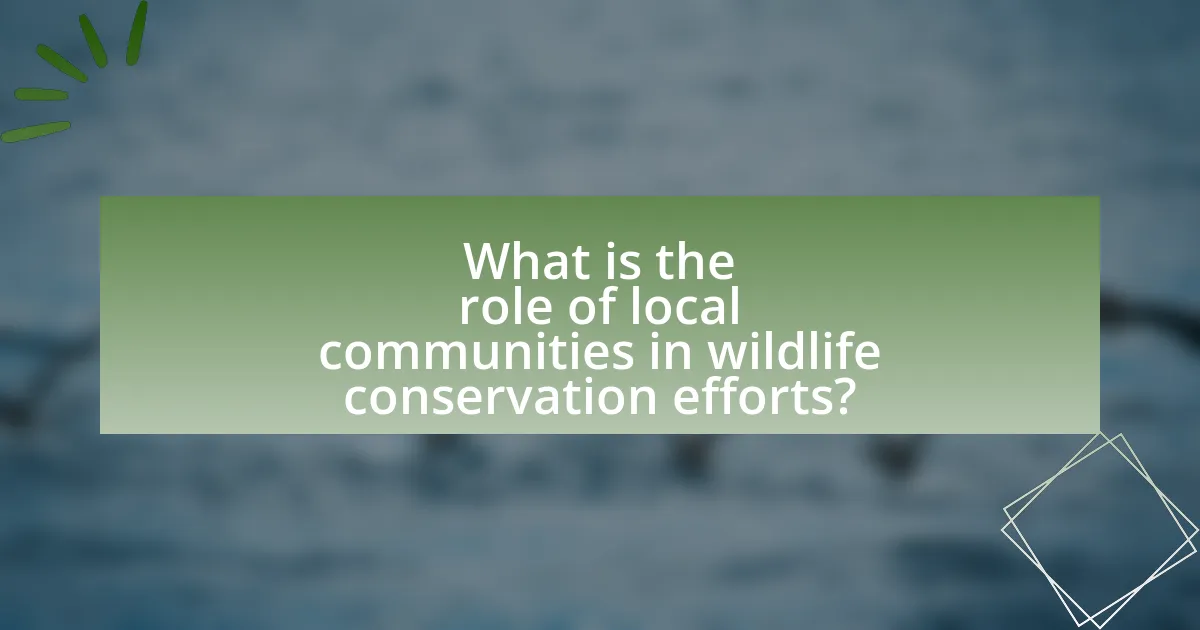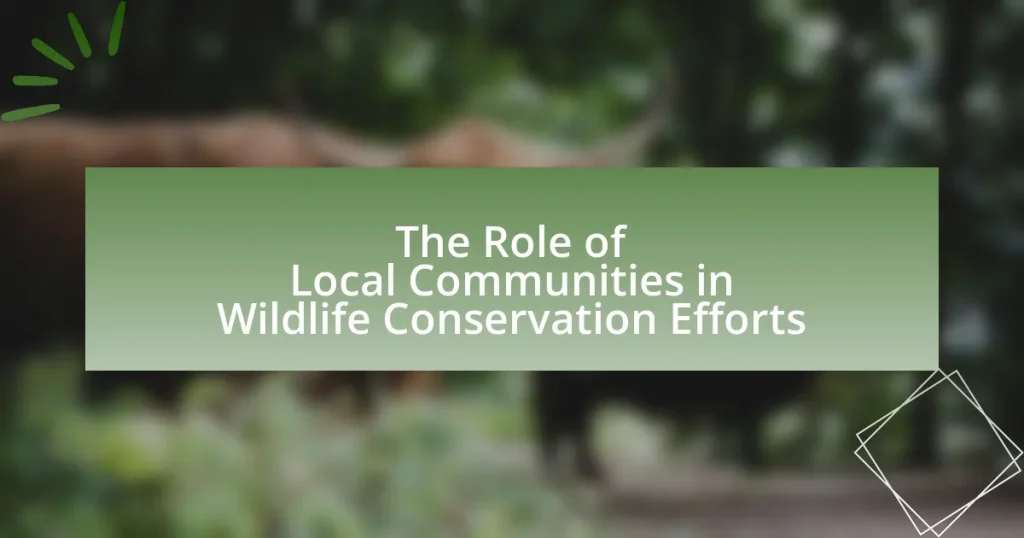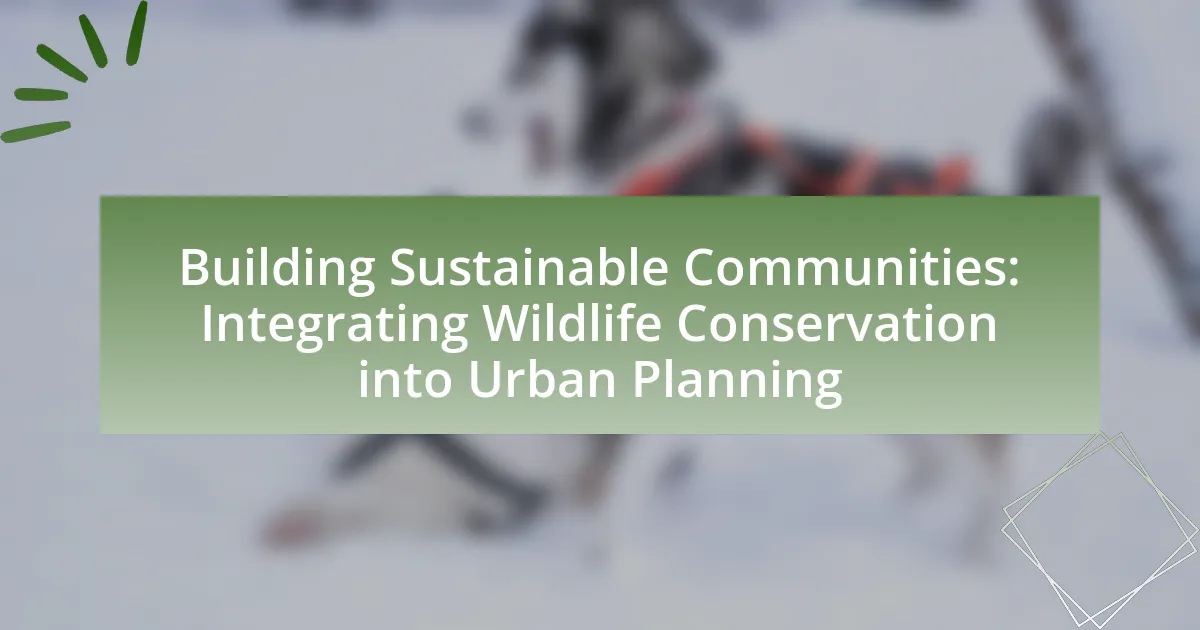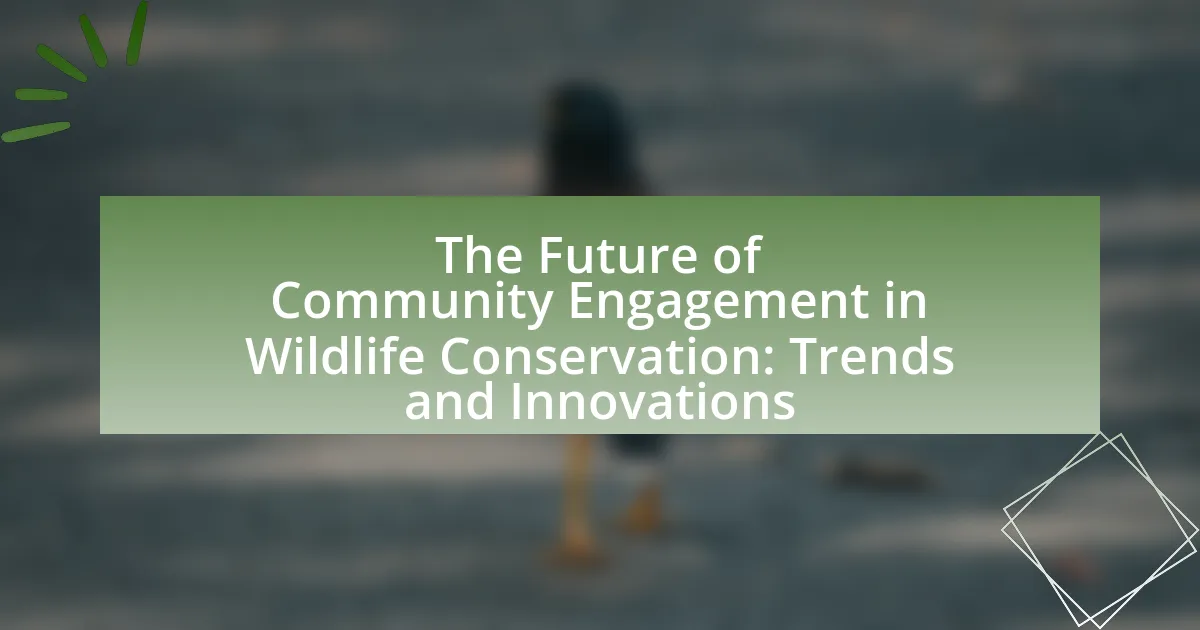Local communities are integral to wildlife conservation efforts, as their active participation enhances the protection and management of natural resources. This article explores how local knowledge contributes to effective conservation strategies, highlighting successful initiatives such as community-based natural resource management in Namibia and ecotourism in Kenya. It discusses specific actions taken by communities, the socio-economic factors influencing their involvement, and the challenges they face. Additionally, the article examines the role of NGOs and government policies in supporting community-led conservation, showcasing case studies that demonstrate the positive impact of local engagement on biodiversity and sustainable wildlife management.

What is the role of local communities in wildlife conservation efforts?
Local communities play a crucial role in wildlife conservation efforts by actively participating in the protection and management of natural resources. Their involvement often leads to more effective conservation strategies, as they possess valuable local knowledge about ecosystems and species. For instance, studies have shown that community-based conservation initiatives, such as those in Namibia, have resulted in increased wildlife populations and improved habitat management due to local stewardship and engagement. Additionally, when communities are empowered through education and economic incentives, they are more likely to prioritize conservation over exploitation, demonstrating that local involvement is essential for sustainable wildlife management.
How do local communities contribute to wildlife conservation?
Local communities contribute to wildlife conservation by actively participating in habitat protection, sustainable resource management, and biodiversity monitoring. These communities often possess traditional ecological knowledge that enhances conservation strategies, as evidenced by initiatives like community-based natural resource management (CBNRM) in Namibia, which has led to increased populations of endangered species such as the black rhino. Furthermore, local involvement in ecotourism generates economic incentives for conservation, demonstrated by the success of community-run wildlife reserves in Kenya, where local stewardship has resulted in a significant reduction in poaching rates.
What specific actions do local communities take for conservation?
Local communities engage in various specific actions for conservation, including habitat restoration, sustainable resource management, and community-based wildlife monitoring. Habitat restoration efforts often involve reforestation projects, where communities plant native trees to restore ecosystems, as seen in initiatives like the Green Belt Movement in Kenya, which has led to the planting of over 51 million trees since 1977. Sustainable resource management practices include implementing fishing quotas and rotational grazing to prevent overexploitation of resources, which has been effective in regions like the Pacific Islands, where local fisheries have seen recovery due to community-led management. Additionally, community-based wildlife monitoring programs, such as those in Namibia, empower locals to track wildlife populations and report poaching incidents, contributing to increased wildlife protection and biodiversity conservation. These actions demonstrate the critical role local communities play in effective conservation strategies.
How do local communities engage with wildlife management practices?
Local communities engage with wildlife management practices through participatory approaches that involve collaboration in decision-making and implementation. These communities often contribute local knowledge, which is crucial for effective management strategies, and participate in monitoring wildlife populations and habitats. For instance, in many regions, community-based conservation programs have been established, allowing local residents to manage resources sustainably while benefiting economically from wildlife tourism. Research indicates that when local communities are actively involved, such as in the case of Namibia’s communal conservancies, wildlife populations have increased, demonstrating the effectiveness of community engagement in wildlife management.
Why are local communities essential for effective conservation?
Local communities are essential for effective conservation because they possess intimate knowledge of their local ecosystems and have a vested interest in their preservation. This local expertise enables communities to implement sustainable practices that align with conservation goals, as evidenced by studies showing that community-led initiatives often lead to better biodiversity outcomes. For instance, the World Resources Institute found that areas managed by local communities can have up to 50% higher biodiversity than those managed by external entities. Additionally, when local communities are engaged in conservation efforts, they are more likely to support and enforce regulations, leading to more effective protection of wildlife and habitats.
What unique knowledge do local communities possess about their ecosystems?
Local communities possess unique knowledge about their ecosystems, including traditional ecological practices, species behavior, and resource management techniques. This knowledge is often derived from generations of interaction with their environment, allowing them to understand seasonal changes, local biodiversity, and sustainable harvesting methods. For instance, Indigenous peoples in the Amazon rainforest have detailed knowledge of medicinal plants and their uses, which has been documented in studies highlighting their contributions to biodiversity conservation. Such insights are critical for effective wildlife conservation efforts, as they can inform management strategies that align with ecological realities and cultural values.
How does community involvement enhance conservation outcomes?
Community involvement enhances conservation outcomes by fostering local stewardship and increasing compliance with conservation initiatives. When communities actively participate in conservation efforts, they develop a sense of ownership and responsibility towards their local environment, which leads to more effective protection of biodiversity. Research indicates that areas with strong community engagement, such as the Maasai Mara in Kenya, have seen significant improvements in wildlife populations and habitat preservation due to local management practices and reduced poaching rates. This correlation between community involvement and successful conservation is supported by studies showing that local knowledge and cultural values contribute to more sustainable resource management.
What challenges do local communities face in conservation efforts?
Local communities face significant challenges in conservation efforts, primarily due to limited financial resources and lack of access to education about sustainable practices. These constraints hinder their ability to implement effective conservation strategies. For instance, a study by the World Wildlife Fund indicates that communities with insufficient funding often struggle to maintain protected areas, leading to habitat degradation and loss of biodiversity. Additionally, inadequate education can result in a lack of awareness about the importance of conservation, further complicating local engagement in sustainable practices.
What socio-economic factors impact local community participation?
Socio-economic factors that impact local community participation include income levels, education, access to resources, and social cohesion. Higher income levels often correlate with increased participation, as individuals with more financial stability can allocate time and resources to community activities. Education enhances awareness and understanding of conservation issues, leading to greater involvement. Access to resources, such as funding and infrastructure, facilitates participation by providing necessary support for community initiatives. Additionally, strong social cohesion within a community fosters collaboration and collective action, which are essential for effective participation in wildlife conservation efforts. Studies have shown that communities with higher educational attainment and economic stability are more likely to engage in conservation activities, demonstrating the significant influence of these socio-economic factors.
How do conflicts with external stakeholders affect conservation initiatives?
Conflicts with external stakeholders negatively impact conservation initiatives by creating barriers to collaboration and resource allocation. When external parties, such as corporations or government entities, oppose conservation efforts, it can lead to reduced funding, increased regulatory challenges, and diminished community support. For instance, a study by the World Wildlife Fund found that projects facing opposition from local industries often experience delays and budget overruns, undermining their effectiveness. Additionally, unresolved conflicts can foster distrust among local communities, further complicating conservation efforts and leading to a lack of engagement from those who are crucial for successful implementation.
How can local communities be supported in their conservation efforts?
Local communities can be supported in their conservation efforts through funding, education, and collaboration with governmental and non-governmental organizations. Providing financial resources enables communities to implement conservation projects effectively, as evidenced by the success of initiatives like the Global Environment Facility, which has funded over 4,000 projects in 170 countries since its inception. Education programs raise awareness about biodiversity and sustainable practices, leading to better community engagement and stewardship. Additionally, partnerships with organizations such as the World Wildlife Fund facilitate knowledge sharing and technical support, enhancing local capacity for conservation.
What role do NGOs play in empowering local communities for conservation?
NGOs play a crucial role in empowering local communities for conservation by providing resources, education, and support for sustainable practices. They facilitate community engagement in conservation efforts, ensuring that local voices are heard and integrated into decision-making processes. For instance, NGOs often conduct training programs that enhance local knowledge about biodiversity and sustainable resource management, leading to improved conservation outcomes. Research shows that when local communities are actively involved, such as in the case of the African Wildlife Foundation’s initiatives in Kenya, conservation success rates increase significantly, demonstrating the effectiveness of community-led approaches.
How can government policies facilitate community-led conservation?
Government policies can facilitate community-led conservation by providing legal frameworks, financial incentives, and technical support that empower local communities to manage natural resources sustainably. For instance, policies that recognize and formalize land rights enable communities to take ownership of conservation efforts, as seen in the case of the Community Forest Management program in Nepal, which has led to a significant increase in forest cover and biodiversity. Additionally, funding programs like the Global Environment Facility support community initiatives, demonstrating that financial backing can enhance local conservation capacity. By integrating local knowledge and practices into national conservation strategies, governments can create a collaborative environment that fosters effective conservation outcomes.
What successful examples exist of local communities in wildlife conservation?
Successful examples of local communities in wildlife conservation include the Maasai Mara community in Kenya and the community-based conservation initiatives in Namibia. The Maasai Mara community has effectively engaged in wildlife tourism, generating revenue that supports both conservation efforts and local livelihoods, resulting in increased populations of species like elephants and lions. In Namibia, community conservancies have led to a significant recovery of wildlife populations, with over 40% of the country’s land now managed by local communities, which has contributed to the resurgence of species such as the black rhino and desert-adapted elephants. These examples demonstrate the effectiveness of local community involvement in sustainable wildlife management and conservation.
What case studies highlight effective community-led conservation projects?
Case studies that highlight effective community-led conservation projects include the Campfire Program in Zimbabwe, which empowers local communities to manage wildlife resources, resulting in increased wildlife populations and economic benefits. Another example is the Maasai Mara Wildlife Conservancies in Kenya, where local Maasai communities collaborate to protect wildlife while benefiting from eco-tourism, leading to improved livelihoods and conservation outcomes. Additionally, the Community-Based Natural Resource Management (CBNRM) program in Namibia has successfully involved local communities in managing natural resources, demonstrating significant biodiversity conservation and sustainable land use. These case studies provide concrete evidence of the positive impact of community involvement in conservation efforts.
How have local communities achieved sustainable wildlife management?
Local communities have achieved sustainable wildlife management through collaborative practices that integrate traditional knowledge with modern conservation techniques. For instance, community-based conservation initiatives, such as the establishment of wildlife reserves and the implementation of sustainable hunting practices, have been effective in maintaining biodiversity while supporting local livelihoods. Evidence from the Namibian communal conservancies demonstrates that local governance structures empower communities to manage wildlife resources sustainably, leading to increased wildlife populations and economic benefits from eco-tourism. Additionally, participatory approaches in resource management have fostered a sense of ownership among community members, further enhancing conservation outcomes.
What best practices can local communities adopt for wildlife conservation?
Local communities can adopt several best practices for wildlife conservation, including habitat restoration, sustainable land use, and community-based monitoring. Habitat restoration involves replanting native vegetation and rehabilitating degraded ecosystems, which supports biodiversity and enhances wildlife habitats. Sustainable land use practices, such as agroforestry and responsible tourism, minimize environmental impact while providing economic benefits to the community. Community-based monitoring engages local residents in tracking wildlife populations and ecosystem health, fostering stewardship and awareness. These practices have been shown to improve conservation outcomes, as evidenced by successful initiatives in regions like the Amazon rainforest, where local involvement has led to a significant reduction in deforestation rates.
How can local communities leverage traditional knowledge for conservation?
Local communities can leverage traditional knowledge for conservation by integrating indigenous practices and ecological insights into modern conservation strategies. This approach enhances biodiversity management, as traditional knowledge often includes sustainable resource use practices developed over generations. For instance, the use of fire management techniques by Indigenous Australians has been shown to reduce the risk of large-scale wildfires while promoting the growth of native species. Studies indicate that areas managed with traditional ecological knowledge often exhibit higher biodiversity levels compared to those managed solely by contemporary methods. By valuing and incorporating this knowledge, local communities can create more effective conservation initiatives that are culturally relevant and ecologically sound.
What strategies can enhance community engagement in conservation efforts?
Strategies that can enhance community engagement in conservation efforts include participatory decision-making, education and awareness programs, and incentive-based conservation initiatives. Participatory decision-making allows community members to have a voice in conservation planning, fostering ownership and commitment to local projects. Education and awareness programs, such as workshops and school curricula, increase knowledge about local ecosystems and the importance of conservation, leading to more informed community members. Incentive-based initiatives, like eco-tourism or payment for ecosystem services, provide tangible benefits to communities, motivating them to actively participate in conservation efforts. Research shows that communities involved in decision-making processes are more likely to support and sustain conservation initiatives, as evidenced by successful programs in regions like Costa Rica and Namibia.




